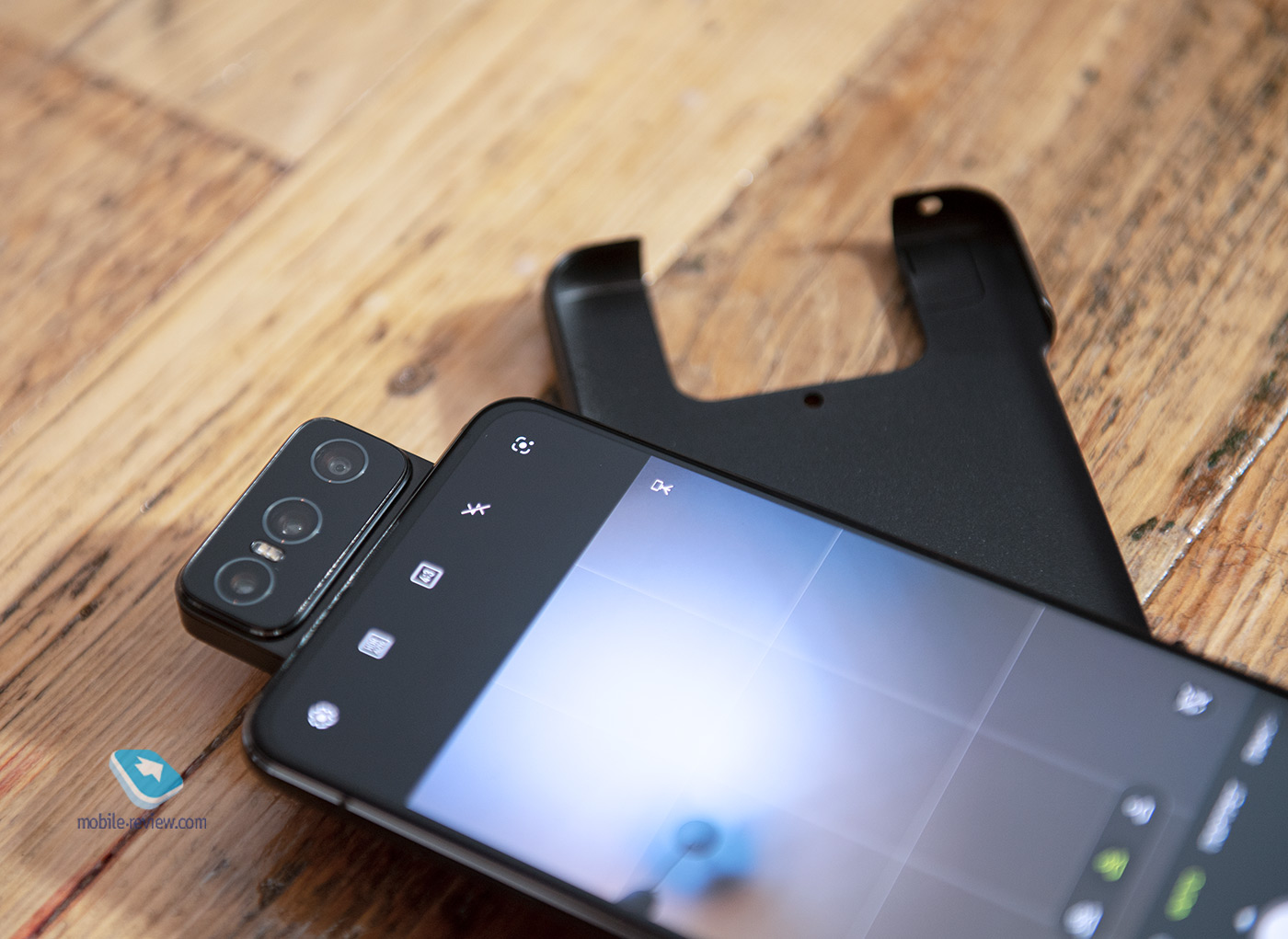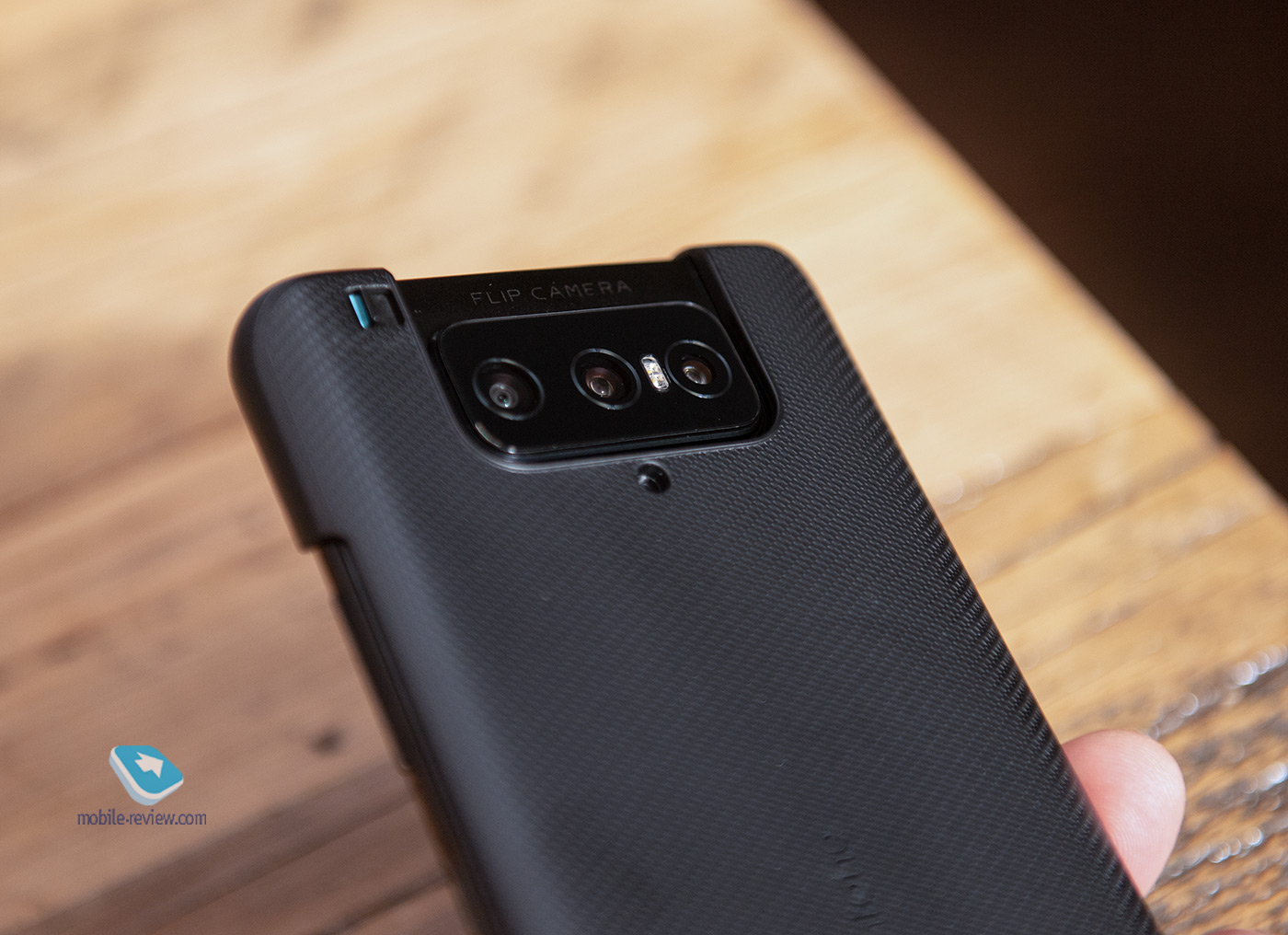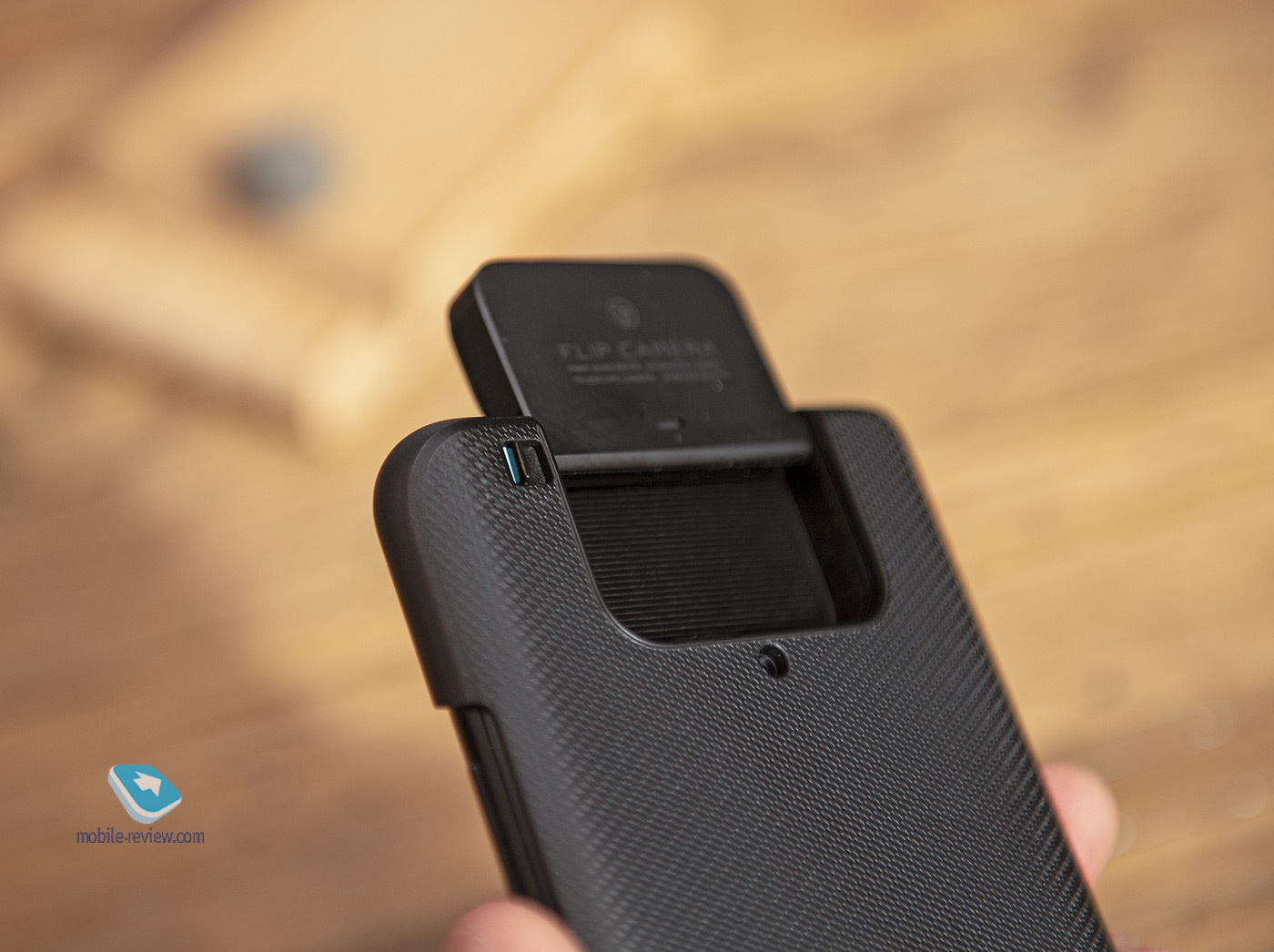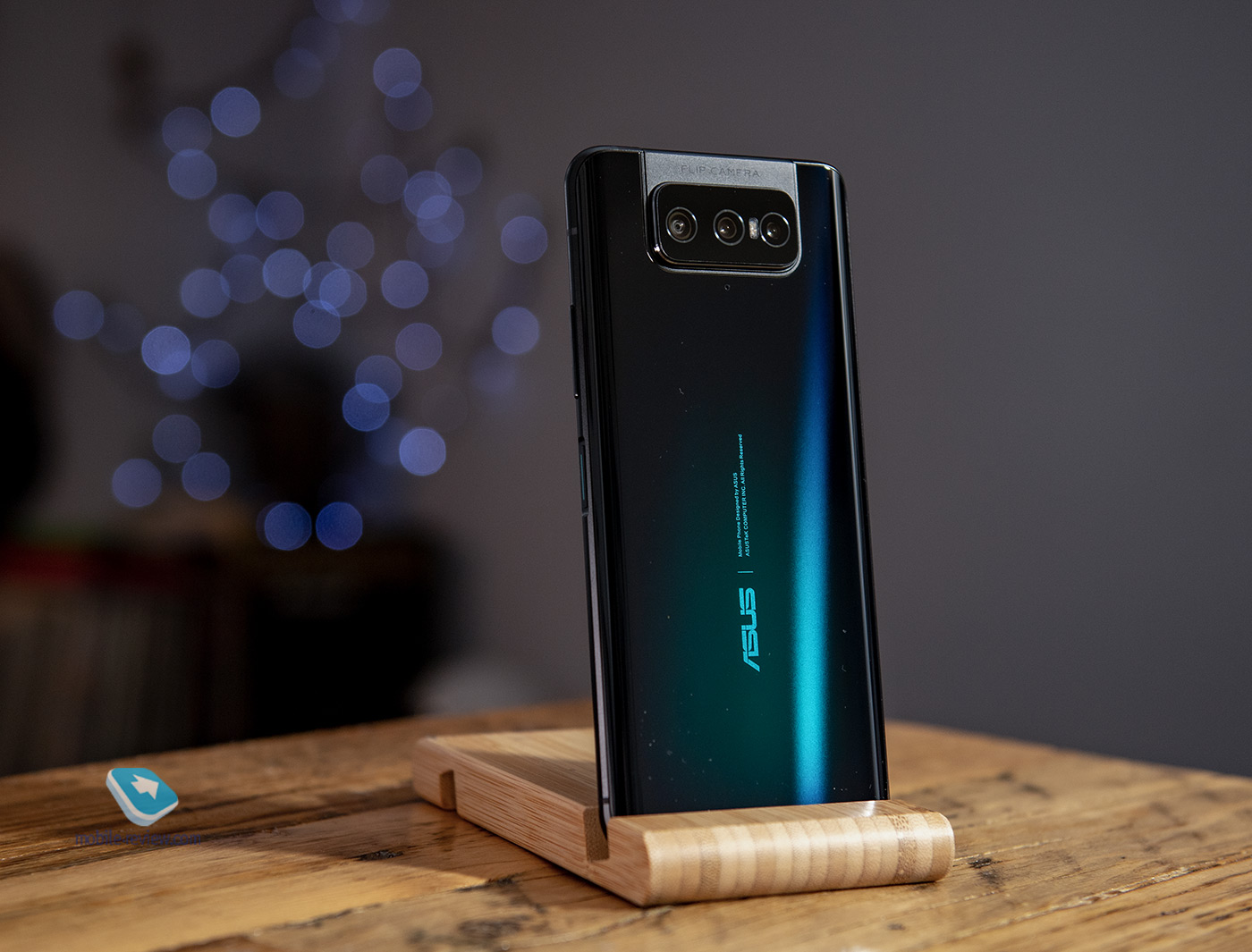
Content
- Contents of delivery
- TECH SPECS
- Positioning
- Design, dimensions, controls
- Display
- Battery
- Memory, chipset, performance
- Communication capabilities
- Camera
- Software
- Competitors
- conclusions

Contents of delivery
- Smartphone
- USB Type-C to Type-C cable
- 30w charger
- SIM eject tool
- Active Case
- Silicone Case
- Documentation (user manual, warranty card)

| TECH SPECS | |
| Dimensions and weight | 165.1 x 77.3 x 9.6 mm, 230 grams |
| Body materials | Gorilla Glass 6 on the front, Gorilla Glass 3 on the back, aluminum frame |
| Display | 6.67 inches, 2400×1080 pixels (FullHD +), Super AMOLED, 20: 9 ratio, 395 ppi pixel density Refresh rate 90 Hz, response time 1 ms HDR10 +, 10-bit color depth, 110% DCI-P3 (105% NTSC) color gamut Brightness 700cd / m2, Delta E <1, SGS Certified |
| Operating system | Google Android 10 (Android 11 beta testing in progress), ZenUI 7 graphical add-on |
| Platform | Qualcomm Snapdragon 865 Plus (4 × 1.8 GHz Cortex-A55 + 3 × 2.42 GHz Cortex-A77 + 1 × 3.1 Cortex-A77), 7 nm process technology, Adreno 650 graphics |
| Memory | 8GB RAM (LPDDR5), 256GB UFS 3.1 onboard storage, microSD card support up to 2TB (dedicated slot) |
| Wireless Interfaces | Multi-antenna Wi-Fi 6 802.11 a / b / g / n / ac / ax, 2.4 / 5 GHz, 2×2 MIMO, Wi-Fi direct; Bluetooth 5.1 (BR / EDR + LE, aptX Adaptive), NFC |
| Сеть | 2G: EDGE / GSM / GPRS bands 850/900/1800/1900, 3G: диапазоны WCDMA 1/2/3/4/5/6/8/19, 4G: диапазоны FDD LTE 1/2/3/4/5/7/8/12/13/17/18/19/20/25/26/28/29 TDD LTE bands 38/39/40/41/42/48 Dual Nano SIM cards 5G / 4G standby |
| Navigation | GPS, AGPS, BeiDou, GLONASS, GALILEO, QZSS, NavIC |
| Sensors and connectors | Side fingerprint scanner, accelerometer, camera module rotation angle sensor, gyroscope, light sensor, electronic compass, proximity sensor, Hall sensor, USB Type-C, no headphone jack |
| Камеры | – 64 MP, wide angle, Sony IMX686, Quad Bayer, f / 1.8 aperture, 0,8 μm, PDAF (phase detection autofocus), 4-axis OIS, 26 mm equivalent focal length – 8 MP, telephoto, f / 2.4, 80 mm equivalent focal length, PDAf, OIS, 12x optical zoom, digital zoom XNUMXx – 12 MP, ultra-wide lens, Sony IMX363, f / 2.2, 1,4 μm, angle of view 113 °, equivalent focal length 17 mm, dual-pixel autofocus (PDAF), macro photography at a distance of 4 cm – Video recording: – Slow motion: – Accelerated shooting: – EIS-stabilization on three axes (except modes with 240 and 480 fps) |
| Battery | Li-Po, 5000 mAh, Fast Charging 30W, Supports Quick Charge 4.0 and USB Power Delivery 3.0, Reversible 10W Wired Charging, Direct Charge |
| Audio | Stereo speakers, dual amplifier, Qualcomm Audio codec support, triple microphone system with ASUS Noise Reduction technology |
| Additionally | Rotary motorized camera module, face detection, screen flicker reduction, dual LED flash, additional video recording modes, Always-On mode |
| Color | White black |
| Price | 67 990 rubles |
Positioning
In addition to the gaming line of ROG Phone smartphones, the ASUS catalog also includes ZenFone, which until last year produced smartphones that were not bad in their characteristics, but in general did not stand out too much against the background of other models. But ASUS ZenFone 6 showed that the company has something to surprise: the implementation of a PTZ camera has definitely become an extraordinary move that users will remember. At the same time, the “stuffing” of the smartphone looked pretty good, Roman Belykh wrote about it.
And so ASUS announced the start of sales on the Russian market of two smartphones at once – ZenFone 7 Pro and ZenFone 7. In them – the continuation and evolution of the idea of the previous generation: the camera unit acquired a third lens, the hardware was pulled up to the modern level, having received a number of typical for the current model years of characteristics. As for the differences between the devices, they are minimal and relate to purely hardware:
| Processor | ROM | OIS | |
| ASUS ZenFone 7 Pro | Qualcomm Snapdragon 865 Plus | 256 GB | + |
| ASUS ZenFone 7 | Qualcomm Snapdragon 865 | 128 GB | — |
The main difference is, of course, the optical stabilization of the telephoto lens and the main camera. In terms of size and other characteristics, full parity is observed. Adjusted for the differences described, most of the features described in the text apply to both smartphones.
Design, dimensions, controls


On both sides, the smartphone is protected by Gorilla Glass, in front it is flat with a slight 2.5-rounding of the screen, behind the rounding of the back to the edges is more pronounced, but still not 3D. The Aurora Black version was tested: on a seemingly black case, when changing the viewing angle, a gradient appears in the colors of the northern lights. The effect when it appears briefly slightly stains the body in greenish tones, it is definitely not accented. In the white version, the gradient color will be pink-blue. The manufacturer’s logo is applied in the center of the backrest, next to it there is an inscription about the protection of rights and design by the company. For my taste, this element is quite large and does not look very pleasant, I would only leave the logo.
In terms of its dimensions and weight, ASUS ZenFone 7 Pro somehow reminded me of ROG Phone devices: a rather wide and weighty body, a comfortable grip, and similar tactile sensations. The main difference, of course, is the absence of any cutouts in the display and in a kind of rotary module of the main camera, we will certainly return to these features a little later. The camera block protrudes slightly above the surface of the case. Due to its location in the center of the case, it practically does not interfere with anything: if the phone is on the table, that is, a small and uncritical backlash, text input in this mode is carried out without problems, as well as interaction with the upper part of the screen. Of course, it would be better if this bump did not exist at all, but in the case of the ZenFone 7 Pro, everything is already pretty good.

On the left side panel there is a slot for two SIM-cards and one memory card, all three cards can be used simultaneously. Support for expanding the built-in memory with a microSD card up to 2 TB is declared. The main controls are on the right panel: a combined volume rocker and a power button with a built-in fingerprint scanner. The button is physical and has a small pressing stroke with a quiet soft click, but you don’t need to press it to unlock it, just lean your finger on it. In the settings, options for calling various commands by double or single pressing a key are available, whether it is launching the camera, Google Assistant or a selected application. The fingerprint reading speed is quite fast, not to say that it is a record one, it is quite suitable sensor for everyday work. Was it worth hiding the scanner in the screen? It’s a difficult question, it’s probably an individual matter. Write in the comments which location of the scanner is closer to you.




At the bottom there is a Type-C connector, which “learned” to work with external SSDs without any OTG adapters and adapters, at least it was on the example of this smartphone that I discovered this feature. Here, below, there are slots for the speaker and microphone, as well as an LED indicator. The unexpected location of an element that is pleasant in all respects will be appreciated by many users, in the comments I often meet similar wishes to many manufacturers. There is no 3.5 mm jack, as in many modern smartphones, someone will definitely not like this step.
Display

Not so often on the test there are smartphones without any slots and “bangs” in the display. Apparently, this is why the ZenFone 7 Pro screen gave me such aesthetic pleasure: the single space of a large display with small bezels is the form factor of the front panel that I singled out for myself as ideal after meeting the first two generations of Oppo Reno. By the way, in two generations of ROG Phone, I liked the display in this regard, except that the frame on top is slightly thicker because of the front camera.
The screen is made by Samsung and its characteristics are close to gaming smartphones: high color accuracy coupled with a refresh rate of 90 Hz and fast response gives a great user experience. Of course, here is not the highest hertz ratio, as in the same ROG Phone, but not 60 Hz either, it would be extremely strange in light of current trends. The 60 Hz mode is present, but visually it looks much less preferable.
Super AMOLED provides natural color reproduction that is, of course, customizable. The declared color gamut of 110% DCI-P3, a good indicator for a smartphone that does not seem to be positioned as a gaming one.For those whose eyes are affected by PWM, DC Dimming mode is available. Well, as an additional “feature” there is a mode for use with gloves, which is now doubly relevant.


For the display, the declared brightness is up to 700 cd / m2, which in practice gives a clear image even in direct sunlight, which, however, was not so much during the testing period of the smartphone. If you are not averse to “getting stuck” in your smartphone before going to bed, then you will appreciate the minimum screen brightness, which will allow you to comfortably use ZenFone 7 Pro in the dark without burning your eyes. The smartphone can only be praised for the quality of the display and the absence of any elements in it, it definitely falls into my personal top.
Battery
The capacity of the standard battery is 5000 mAh and allows you to comfortably work up to two days in mixed mode. In my standard use of several instant messengers and mailboxes, this result was obtained clearly. The video looping test showed a little over 23 hours, while switching to 60 Hz improved the result by just an hour. The settings include dedicated power saving modes, as well as proprietary charging modes that help preserve battery vitality. For example, you can limit the maximum charging percentage to 80%, or set a charging schedule. Custom modes are also available, which you can customize according to your own needs.
The complete charger charges the smartphone up to 35% in 60 minutes. A full charge will take just over an hour and a half.
Memory, chipset, performance
I think one glance at the characteristics is already enough for a rough understanding of the performance picture. Personally, in two weeks of testing, I have not found anything to complain about. The system works without any glitches and crashes, fast memory is used, which in combination with the currently flagship Qualcomm processor gives a very pleasant user experience, including in games.
In my memory, this is the first smartphone on which I managed to run PUBG with the highest texture quality, in this mode the average frame rate was 39.1 fps, while the processor worked at 85% and warmed up to an average of 51 degrees. The heating of the case was felt, there was no talk of any critical figures. Who, if not ASUS, know how to cope with the cooling of their devices. When you roll back to high settings, it already turned out to bring the performance to a stable 59 frames per second, and in Real Racing 3 – to 90 fps. The results and impressions obtained are confirmed by synthetic tests, which put the ZenFone 7 Pro in a fairly high position.
Communication capabilities
The smartphone has good stereo speakers that help to improve the quality of the gameplay, watching videos and listening to music. In terms of volume, they are slightly inferior to those in the ROG Phone 3, which is not a reproach to them, rather the opposite. The sound is spacious and clear, the maximum volume does not give any distortion, very worthy. The situation is similar with a telephone conversation, everything is at the level, the noise cut-off system works well, the interlocutors do not note any problems with speech transmission.
On site, all kinds of wireless protocols, NFC and GPS work quickly and flawlessly.
Camera
Compared to the previous generation, the rotary module is quieter and faster. Of course, the sound is audible, but in a normal environment it is unlikely to be audible. The camera set now has a very decent telephoto lens, which the ZenFone 6 clearly lacked for versatility. The camera software has separate positional settings for lens rotation, so you don’t have to set the angle manually, although you can if you want. According to the manufacturer’s assurances, the module is designed for 200 rotations, which is obviously longer than the “life” of a single model for an average user.




Otherwise, many aspects are similar to a similar element in ZenFone 6, I will quote the FAQ from a colleague’s review:
- What happens if you try to activate camera rotation when the phone is lying with its back down? Even if face recognition is attempted, the camera will not rotate.
- How far is the camera completely retracted into the case if the phone is dropped? From about one and a half meters.
- What happens if the camera encounters an obstacle when closing? It rests against an obstacle, and the closing mechanism is disabled. The camera will lock in the position in which it was jammed.
- Can I rotate the module myself? Can. If it is closed, you will have to pry it off. If in the open, it is easy to move.
- How does face unlock work? After activating the screen (after picking it up or pressing the power button), unfortunately, you have to touch the icon with a smiley. That is, the camera does not automatically move out. This is a little uncomfortable. After recognition, the camera turns back.
- How fast is recognition? Not very fast, as the module takes 0.5 seconds to complete a turn and 0.2-0.3 seconds to recognize. Plus 0.5 seconds to turn back.
- Or can the camera recognize a face at night? Yes, maybe due to the presence of laser focusing.
A solution with such a module has the right to life. Of course, it’s hard to class me as a fan of mobile photography. But even I appreciated the benefits of such a system. First of all – a screen without cutouts. Secondly, there is no need to worry about the quality of the front camera, the main camera shoots pretty decently.

Well, the opportunity to experiment with shooting angles gives scope for creativity to people who are open to this. One panorama mode is worth it: the camera, when rotating, captures 6 frames and glues them into one, but it is not at all necessary to hold the smartphone horizontally. Vertical orientation gives interesting results, you can try different angles and perspectives. At the same time, there is also the usual panoramic shooting mode, with the movement of the smartphone.

The Sony IMX686 sensor is familiar from the ROG Phone 3 review, and the quality of daytime shots is generally at the same level: daytime frames are pleasant in detail and dynamics, at night it becomes a little more difficult to catch a frame, there is a dedicated night mode. Color rendition when switching between the main and ultra-wide-angle cameras is minimal, but noticeable in good lighting. The background blur works very well, it can be seen on one of the selfies.
Video examples:
For video shooting, several interesting modes are provided: hyperstabilization, free zoom to any point in the video, wind cutoff and Mic Focus, in which the sound is accentuated on the object captured in focus when the frame is zoomed in. Not new, but a useful feature for those who like to shoot video with a smartphone. Of course, the ASUS ZenFone 7 Pro provides optical stabilization, it is available for the main and telephoto lenses. The smartphone shoots video in resolutions from HD to 8K, there is fast and slow motion.



No matter how strange it may be from the point of view of the usual logic of the narrative, here it is worth mentioning the complete Active Case. It is made of dense textured material that thickens an already not very slim body a little. It is intended for those cases when you need to protect your smartphone from possible external influences – at work in any production, at a construction site, when doing chores or just playing sports. A special lever on the back of the case fixes the camera in a static position and prevents it from rotating. At the same time, the smartphone monitors the position of the lever and notifies about its change with a special icon in the interface. The kit also includes the usual silicone case, such a feature of the package.
Software
The smartphone runs on Android 10, the ZenUI 7 shell is familiar from the already mentioned ROG Phone, where it is present as an interface that is not loaded with game graphic elements. ZenUI is not overloaded with preinstalled software, it is practically absent here. The design is somewhat reminiscent of Google’s version of Android. Despite the apparent simplicity, the system has many settings available, so there would be a desire to personalize. For example, you can select the system color that will highlight the switches in the quick settings panel, active elements and switches, and select the shape of the icons.
Competitors
The cost of ASUS ZenFone 7 Pro is 67 rubles. The most obvious alternative is the junior model: with very similar characteristics and the differences mentioned, it will cost 990 rubles and at the same time looks quite balanced. I think there will be those who are ready to save 59 rubles on optical stabilization, a slight difference in processor frequencies and 990 GB of permanent memory, which can be expanded with a memory card if desired and still remain in the black.
If we abstract from the concept of a PTZ camera, then we can consider the Mi 10 from Xiaomi as a competitor. The Qualcomm Snapdragon 865 processor, the same 90 Hz screen and a camera system with a main lens of 108 megapixels look good, however, there is still a cutout in the screen, a little less battery capacity (4780 mAh), memory parity. Not in favor of the device from Xiaomi says its exoticism on the market, but in one of the large networks at the time of writing, it costs 49 rubles, which is 990 rubles lower than its price in the official store.
In the same price range, there is another variant from Xiaomi – POCO F2 Pro. The front camera is hidden in the body, so nothing disturbs the screen. In terms of processor and memory, the situation is the same as in Mi 10, except that the cameras are a little simpler, but still suitable.
From the Samsung camp, I would single out the Samsung Galaxy S20 +, with its good photo capabilities in terms of performance, there will still be an advantage on the side of ASUS ZenFone 7 Pro. If you search, you can find a smartphone at a very tasty price, comparable to the hero of the review.
If 8 GB of RAM is not enough and you want something exotic, then one of the operator networks, again at the time of this writing, offers Motorola Edge Plus, this rare flagship for our market will cost 79 rubles, which, of course, is too much, but, in general, there is such an option.

Left to right: ASUS ZenFone 7 Pro, ASUS ZenFone 7, Motorola Edge Plus, POCO F2 Pro, Samsung Galaxy S20 +, Xiaomi Mi 10
conclusions
A curious and distinctive smartphone will definitely appeal to those who are looking for everything at once. There is almost a complete set here: a productive processor, sane autonomy, good cameras, a neat shell. And if you, like me, choose a smartphone based on a set of characteristics and prefer a single display without any cutouts, then ASUS ZenFone 7 Pro will become one of the main candidates for purchase. Of the possible complaints, it is worth highlighting the lack of any declared water protection and a headphone jack, as well as subjective points – the large weight, thickness and location of the fingerprint scanner.

In my subjective opinion, ASUS ZenFone 7 Pro turned out to be successful and at least interesting, although towards the end of testing I played enough with a rotary camera and practically did not use it as a front camera, which, in general, corresponds to my scenarios. I am sure that such a smartphone will be a good option for those who like to take pictures, while there are no compromises in performance, and I have not found any significant drawbacks for myself.
Back to content >>>
Related Links
Share:
we are in social networks:
Anything to add ?! Write … eldar@mobile-review.com





